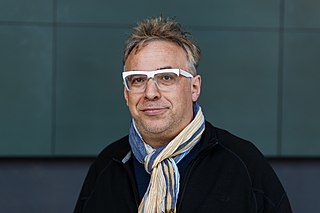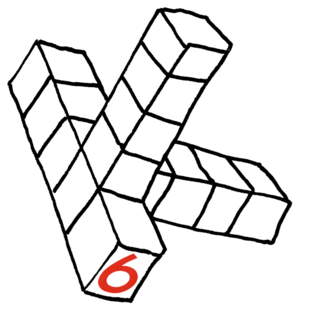Related Research Articles

Dziga Vertov was a Soviet pioneer documentary film and newsreel director, as well as a cinema theorist. His filming practices and theories influenced the cinéma vérité style of documentary movie-making and the Dziga Vertov Group, a radical film-making cooperative which was active from 1968 to 1972. He was a member of the Kinoks collective, with Elizaveta Svilova and Mikhail Kaufman.

Film editing is both a creative and a technical part of the post-production process of filmmaking. The term is derived from the traditional process of working with film which increasingly involves the use of digital technology.
Man with a Movie Camera is an experimental 1929 Soviet Ukrainian silent documentary film, directed by Dziga Vertov and edited by his wife Yelizaveta Svilova.
Paradigmatic analysis is the analysis of paradigms embedded in the text rather than of the surface structure (syntax) of the text which is termed syntagmatic analysis. Paradigmatic analysis often uses commutation tests, i.e. analysis by substituting words of the same type or class to calibrate shifts in connotation.
In semiotics, syntagmatic analysis is analysis of syntax or surface structure as opposed to paradigms. This is often achieved using commutation tests.

Lev Manovich is an author of books on new media theory, and professor of Computer Science at the Graduate Center, City University of New York. Manovich's research and teaching focuses on digital humanities, social computing, new media art and theory, and software studies.
The Kuleshov effect is a film editing (montage) effect demonstrated by Soviet filmmaker Lev Kuleshov in the 1910s and 1920s. It is a mental phenomenon by which viewers derive more meaning from the interaction of two sequential shots than from a single shot in isolation.
Jennifer and Kevin McCoy are a Brooklyn, New York-based married couple who make art together, and still continue to make projects together. They work with interactive media, film, performance and installation to explore personal experience in relation with new technology, the mass media, and global commerce with work that is highly influenced through the perspective of Lev Manovich. They often re-examine classic genres and works of cinema, science fiction or television narrative, creating sculptural objects, net art, robotic movies or live performance They have projects that are collection of subcategories. In 2002 they received the Creative Capital Award in the discipline of Emerging Fields. They were awarded a 2011 Guggenheim Fellowship.
Soviet montage theory is an approach to understanding and creating cinema that relies heavily upon editing. It is the principal contribution of Soviet film theorists to global cinema, and brought formalism to bear on filmmaking.
Matthew Ritchie is a British artist who currently lives and works in New York City. He attended the Camberwell School of Art from 1983 to 1986. He describes himself as "classically trained" but also points to a minimalist influence. His art revolves around a personal mythology drawn from creation myths, particle physics, thermodynamics, and games of chance, among other elements.
T_Visionarium is an art installation by Neil Brown, Dennis Del Favero, Jeffrey Shaw and Peter Weibel developed through the iCinema Centre for Interactive Cinema Research at The University of New South Wales in co-operation with ZKM Center for Art and Media, Karlsruhe.
Documentary mode is a conceptual scheme developed by American documentary theorist Bill Nichols that seeks to distinguish particular traits and conventions of various documentary film styles. Nichols identifies six different documentary 'modes' in his schema: poetic, expository, observational, participatory, reflexive, and performative. While Nichols' discussion of modes does progress chronologically with the order of their appearance in practice, documentary film often returns to themes and devices from previous modes. Therefore, it is inaccurate to think of modes as historical punctuation marks in an evolution towards an ultimate accepted documentary style. Also, modes are not mutually exclusive. There is often significant overlapping between modalities within individual documentary features. As Nichols points out, "the characteristics of a given mode function as a dominant in a given film…but they do not dictate or determine every aspect of its organization."
Forward Anywhere is a hypertext narrative created by writer Judy Malloy and scientist Cathy Marshall. They started working together in 1993 through the PAIR program at the Xerox Palo Alto Research Center. Malloy and Marshall were one of the first and only pairings of two women in the program "created to bring together scientists and artists, with the hope of initiating a dialog between the two communities, and creating what PAIR program director Rich Gold described as 'new art' and 'new research.'" The pair wrote of their experience working together in the article, "Closure Was Never a Goal in this Piece", explicating their collaboration process and the connections found between each other.

The Korsakow System is a software for creating browser-based dynamic documentaries. Invented in 2000 by Berlin-based artist Florian Thalhofer, Korsakow allows users without any programming expertise to create and interact with non-linear or database-driven narratives, referred to as Korsakow-Films or K-Films. The software can be used to produce documentary, experimental and fictional narrative works and has been integrated into live performance and installation pieces. Korsakow is currently 299 US$ for the PRO version. Educational licenses are also available.

A Sixth Part of the World, sometimes referred to as The Sixth Part of the World, is a 1926 silent film directed by Dziga Vertov and produced by Kultkino. Through the travelogue format, it depicted the multitude of Soviet peoples in remote areas of USSR and detailed the entirety of the wealth of the Soviet land. Focusing on cultural and economic diversity, the film is in fact a call for unification in order to build a "complete socialist society". A mix between newsreel and found footage, Vertov edited sequences filmed by eight teams of kinoks (kinoki) during their trips. According to Vertov, the film anticipates the coming of sound films by using a constant "word-radio-theme" in the intertitles. Thanks to A Sixth Part of the World and his following feature The Eleventh Year (1928), Vertov matures his style in which he will excel in his most famous film Man with a Movie Camera (1929).
Non-narrative film is an aesthetic of cinematic film that does not narrate, or relate "an event, whether real or imaginary". It is usually a form of art film or experimental film, not made for mass entertainment.
New media studies is a relatively young academic discipline that explores the intersections of computing, science, the humanities, and the visual and performing arts. Janet Murray, a prominent researcher in the discipline, describes this intersection as "a single new medium of representation, the digital medium, formed by the braided interplay of technical invention and cultural expression at the end of the 20th century". The main factor in defining new media is the role the Internet plays; new media is effortlessly spread instantly. The category of new media is occupied by devices connected to the Internet, an example being a smartphone or tablet. Television and cinemas are commonly thought of as new media but are ruled out since the invention was before the time of the internet.

In Spring is a 1929 Soviet Ukraine silent experimental documentary directed by Mikhail Kaufman. It was the first independent work of the cinematographer, made in accordance with the ideas of the avant-garde manifesto Kinoks and was Kaufman's directorial debut.

Enthusiasm: The Symphony of Donbas, also referred to as Donbas Symphony or The Symphony of the Donbas Basin, is a 1931 sound film directed by Soviet filmmaker Dziga Vertov. The film was the director's first sound film and also the first of the Soviet production company Ukrainfilm. The film's score is considered experimental and avant-garde because of its incorporation of factory, industrial, and other machine sounds; human speech plays only a small role in the film's sounds.

Kino-Eye is a film technique developed in Soviet Russia by Dziga Vertov. It was also the name of the movement and group that was defined by this technique. Kino-Eye was Vertov's means of capturing what he believed to be "inaccessible to the human eye"; that is, Kino-Eye films would not attempt to imitate how the human eye saw things. Rather, by assembling film fragments and editing them together in a form of montage, Kino-Eye hoped to activate a new type of perception by creating "a new filmic, i.e., media shaped, reality and a message or an illusion of a message - a semantic field." Distinct from narrative entertainment cinema forms or otherwise "acted" films, Kino-Eye sought to capture "life unawares" and edit it together in such a way that it would form a new, previously unseen truth.
References
- ↑ "Non-Linear Narratives: The Ultimate in Time Travel". Archived from the original on 2009-08-20. Retrieved 2009-10-26.
- ↑ Database as a symbolic form (Cambridge. MIT Press, 1998)
- ↑ Cinema as Database: An Art Form Between Old and New
- ↑ "Manovich's Booklet Reader" (PDF). Archived from the original (PDF) on 2009-10-11. Retrieved 2009-10-25.